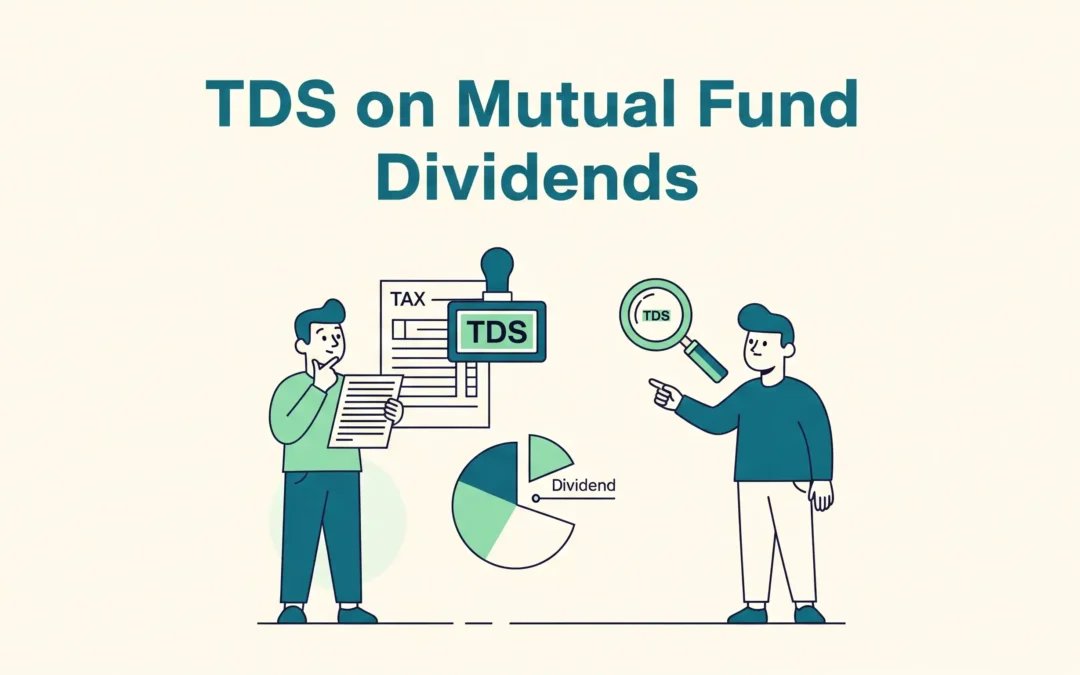Investing in a mutual fund and earning a return may seem easy with the increase in technology and accessibility. But many investors make the mistake of not understanding the TDS on mutual fund dividends. They just focus on researching in the initial stage, i.e., deciding which fund to invest in. Ignoring this factor can affect the net return earned negatively. It may seem a difficult concept to understand, especially for a young investor.
This article will assist you in understanding TDS on mutual fund dividends thoroughly, along with the process to file it and the cases in which it can be avoided.
Understanding TDS on Mutual Fund Dividends
Before the Finance Act 2020, investors didn’t have to pay taxes on dividends they received from mutual funds. Fund houses paid Dividend Distribution Tax (DDT) before the dividends were sent out. The new system, on the other hand, eliminated DDT and placed the tax burden directly on investors.
| Section | Applicability | Threshold | TDS Rate |
| 194 | Payment of dividend | Rs. 10,000 | 10% |
| 194LBA(2) | Dividend Income from a Business Trust by SPV | No Limit | 10% |
| 194K | Payment of earnings for mutual fund units | Rs. 10,000 | 10% |
Key TDS rules to know:
- The threshold limit for TDS deduction on dividend income from mutual funds under Section 194K is Rs. 10,000 per financial year per AMC (increased from Rs. 5,000 from FY 2025-26). There is no Rs. 1,00,000 AMC threshold applicable for TDS.
- Rate of TDS:
- 10% if PAN is updated
- 20% if the PAN is invalid or missing
- It is relevant to dividends from debt and equity mutual funds.
- TDS Deduction is done when the dividend is credited above a certain threshold.
How to Manage TDS When Filing ITR?
In order to avoid alerts, claim refunds, or pay any outstanding tax obligations, it is essential that you properly handle TDS on mutual fund dividends when filing your Income Tax Return (ITR). Here’s how to guarantee correct reporting and compliance since dividend income is now taxable in the investor’s hands and TDS is withheld at the source.
1. Include all dividend income in your ITR.
Including the gross dividend amount in your ITR should be done under the head of “Income from Other Sources.” For instance, you must report ₹5,000 as income if your AMC credited ₹4,500 after deducting ₹500 for TDS.
- Navigate to “Schedule OS” on the ITR Form (Other Sources).
- Enter the entire dividend that was received.
2. Reconcile with AIS and Form 26AS
All TDS withheld by mutual fund houses is reflected in your Annual Information Statement (AIS) and Form 26AS. Before filing, confirm that:
- The entry of ITR’s dividend income and the AIS entries should match.
- The 10% or 20% TDS that was subtracted is accurately reflected.
- All of your mutual fund folios are correctly linked to your PAN.
3. Get TDS Credit
In your ITR form’s TDS Schedule:
- Select the option of “TDS from Other than Salary.”
- Enter your PAN, the AMC’s TAN, the amount of TDS withheld, and the dividend that was paid.
- You are eligible for a refund if too much tax was withheld (for example, if you are in the 5% or 0% tax slab).
How to Avoid TDS?
1. Select the Growth Option Instead of the Dividend
The Growth option reinvests profits rather than paying dividends. Given that there is no reward:
TDS is not applicable.
- Upon redemption, gains are taxed as capital gains rather than income.
- Perfect for tax-efficient, long-term investing.
2. Dividend Income Per AMC Limit
TDS is deducted when dividend income from a single AMC exceeds Rs. 10,000 in a financial year (for FY 2025-26 onwards). Previously, this threshold was Rs. 5,000.
To prevent this:
- Spread your investments among several AMCs.
- Aids in avoiding TDS, but income must still be reported on your ITR.
3. Make a PAN update
Make sure your PAN is linked correctly to prevent a 20% increase in TDS. The TDS rate stays at 10% as long as the PAN is valid.
4. Issue Form 15G/15H.
There are different forms available when the total taxable income is less than the basic exemption threshold. However, depending on the age group, different forms have to be filled out:
- Individuals who are below the age of 60 must fill out Form 15G.
- However, senior citizens, i.e., those aged above 60, should fill out Form 15H.
Bottomline
The conclusion can be drawn that TDS deduction on mutual funds can result in less net returns, affecting wealth accumulation. However, there are ways to legally avoid TDS deduction. Being updated on the changes happening in the tax regime will also play an important part in avoiding paying more. Proper financial planning and awareness are needed to maintain the net returns by avoiding or minimizing deductions. Also, understanding the ITR filing along with various forms to fill out is essential to avoid any default or penalty.
A good investor not only focuses on earning a return but also legally saves it from deductions by making smart choices.
Written by: Tanya Kumari


